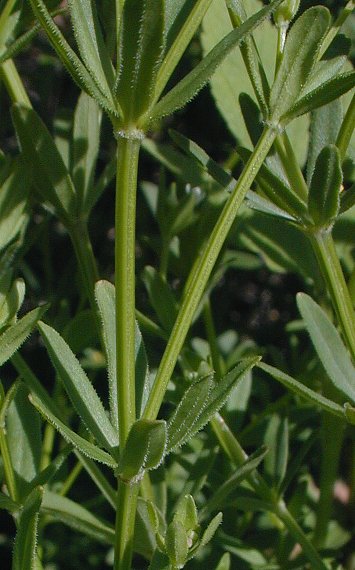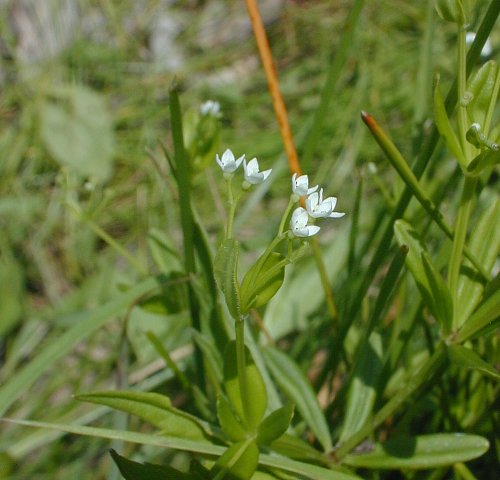Description: This herbaceous perennial plant is about ½–1½' tall, often branching abundantly and presenting a bushy appearance. The weak stems are ascending to sprawling; they are light green, sharply 4-angled, shallowly furrowed along their sides, and mostly glabrous, except where the whorled leaves occur. Near the bases of these leaves, there are narrow rings of dense short hairs on the stems. At intervals along these stems, there are whorls of 4-6 sessile leaves. Where the lower stems branch dichotomously, there are usually whorls of 5-6 leaves, otherwise there are whorls of 4 leaves. Relative to their stems, these leaves are ascending to widely spreading. Individual leaves are ½–1¼" long and about one-fourth as much across; they are elliptic-oblong to oblong in shape, while their margins are entire (toothless) and stiffly ciliate. The upper and lower leaf surfaces are medium green and mostly glabrous. However, the lower leaf surfaces are stiffly short-hairy along their central veins. These hairs can cling for support on adjacent plants.

The upper and
outer stems terminate in dichotomously branched
clusters of 2-4 flowers; there are 1-2 small clusters of 2-4 flowers
per stem. The glabrous peduncles of these floral clusters are up to 1"
long and
the glabrous pedicels of the flowers are up to ½" long. Each flower is
a little
less than ¼" across, consisting of a white corolla with 4 lanceolate
lobes, a pair of pistils, and 4 stamens; the calyx is minute and
insignificant. The inferior ovaries of the pistils are light green, and
glabrous; together they are biglobular in shape. The blooming
period occurs from late
spring to mid-summer, lasting about 1 month. Usually only a few flowers
are in bloom at the same time. After the blooming period, the ovaries
mature into a pair of joined dry fruits; each fruit contains a single
seed. The seeds are about 0.5 mm. long, somewhat flattened, and
globoid. The root system is fibrous.
Cultivation:
The preference is full sun to light shade, wet to moist conditions, and
soil containing organic matter. This plant doesn't like to dry out, and
it slowly fades away after blooming.

Range &
Habitat:
The native Wild Madder is an occasional to locally common plant that
has been reported
from most counties of Illinois. However, it is uncommon or absent in
some central and western counties of the state (see Distribution
Map).
Habitats include wet to moist black soil prairies, prairie swales,
floodplain woodlands, soggy thickets, swamps,
fens, seeps, and shallow ditches along railroads.
This plant tends to occur in grassy or sedge-dominated areas and it
functions as an understory plant in wet to moist prairies. However,
with the destruction of such prairie habitat, it has become less
common than in the past.
Faunal Associations:
Generally, the small white flowers of Wild Madder (Galium obtusum) and
other bedstraws (Galium
spp.) attract small bees and flies, including Halictid
bees, masked bees (Hylaeus
spp.), and Syrphid flies. These insects cross-pollinate
the flowers. Some insects feed destructively on the foliage and other
parts of bedstraws. These species include flower-feeding
larvae of the Bedstraw Midge (Dasineura
americana), foliage-feeding larvae of an
introduced sawfly (Halidamia
affinis), and the larvae of such moths as the Galium
Sphinx (Hyles gallii),
Drab Brown Wave (Lobocleta
ossularia), and White-banded Toothed Carpet (Epirrhoe alternata).
Bedstraws are also summer hosts of the polyphagous Black Cherry Aphid (Myzus cerasi).
Little is known about the floral-faunal relationships of Wild Madder
with vertebrate animals.

Photographic
Location:
The photographs were taken at a moist prairie remnant along an
abandoned railroad in Champaign County, Illinois.
Comments:
Except for the showy Northern Bedstraw (Galium boreale),
bedstraws (Galium spp.) are often overlooked by
prairie restorationists and wildflower enthusiasts because of their
small flowers. Wild Madder can be distinguished from other bedstraws by
the following characteristics: 1) it has smooth hairless stems, 2)
there are usually only 4 leaves per whorl, although sometimes 5-6
leaves per whorl, 3) the fruits are smooth and hairless, 4)
the flowers have 4 corolla lobes, and 5) the leaves are blunt-tipped.
Other bedstraws often have bristly stems and fruits, more than 4 leaves
per whorl, flowers with 3 corolla lobes, and/or leaves with more
pointed
tips. Another common name of Galium
obtusum is Blunt-leaved Bedstraw.